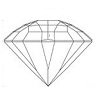11.01: Introduction
- Page ID
- 3235
First and foremost, use your eyes and your brain!
Gemology is a science of elimination. Based on the observation of the various properties of a gem, the possibilities of what it could be are removed until you are left with only one possibility: the correct identification.
Some gems are easily identified with a few simple tests, like rubbing a pearl across your teeth to see if it feels rough or smooth. But before doing so, you have already subconsciously eliminated all of the other gemstones other than pearl based on the visual observations that you have made: color, shape, luster, etc. Of course, the "tooth test" won't tell you if it's cultured or not, or in the case of colored pearls, if they have been irradiated or dyed.
Most gemstones are considerably less easy to identify. In order to isolate the various properties of a gem, gemology requires some specialized equipment.
A word of caution:
- Simply buying the equipment needed for gemology is not enough. One needs formal training from an expert to learn how to apply techniques so one doesn't embrace bad habits that are hard to get rid of.
- It is strongly recommended that you take practical training from one of the institutes outlined in "becoming a gemologist".
Learning the math is not the same as being able to correctly apply it; that's elementary, my dear.


